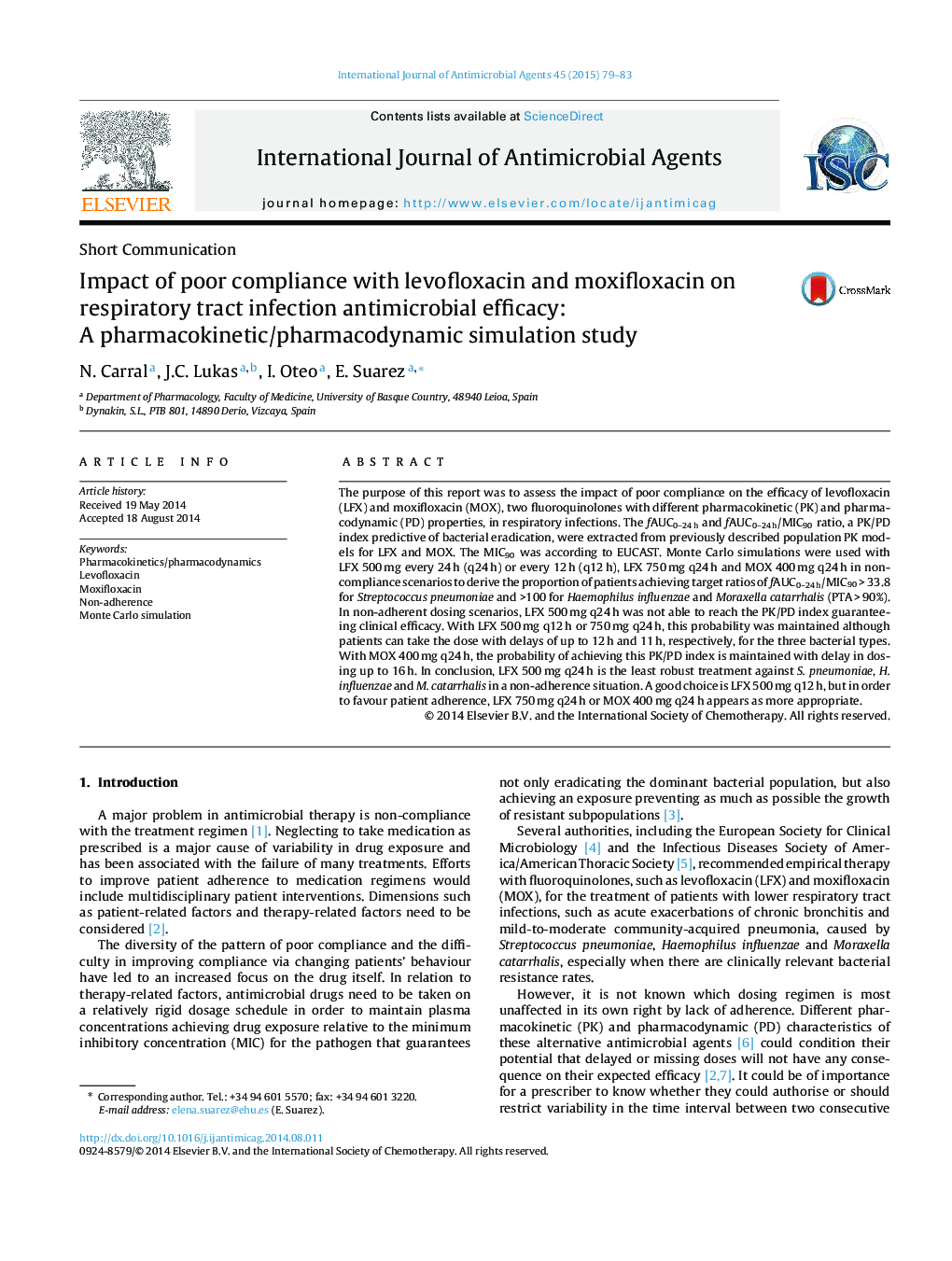| کد مقاله | کد نشریه | سال انتشار | مقاله انگلیسی | نسخه تمام متن |
|---|---|---|---|---|
| 3358745 | 1591771 | 2015 | 5 صفحه PDF | دانلود رایگان |
• The purpose of this report was to assess the impact of poor compliance on efficacy of antimicrobial agents in respiratory infections, as levofloxacin and moxifloxacin, two fluoroquinolones with differences in both pharmacokinetics and pharmacodynamics.
• Monte Carlo simulations were used with levofloxacin and moxifloxacin dosing regimens in noncompliance scenarios, to derive the proportion of patients achieving target ratios of fAUC0–24/MIC90 > 33.8 for S. pneumonia, and fAUC0–24 h/MIC90 > 100 for Haemophilus influenzae and Moraxella catarrhalis (probability of target attainment > 90%).
• In non-adherent dosing scenarios, LVFX 500 mg/24 h was not able to reach the PK/PD index guaranteeing clinical efficacy.
• With the LVFX 500 mg/12 h or 750 mg/24 h regimen, this probability was maintained, although patients can take the dose with a delay of up to 12 and 11 h respectively for respiratory bacterial types.
• With MOX 400 mg/24 h, the probability of achieving this PK/PD index is maintained with delay in dosing regimen up to 16 h later.
The purpose of this report was to assess the impact of poor compliance on the efficacy of levofloxacin (LFX) and moxifloxacin (MOX), two fluoroquinolones with different pharmacokinetic (PK) and pharmacodynamic (PD) properties, in respiratory infections. The fAUC0–24 h and fAUC0–24 h/MIC90 ratio, a PK/PD index predictive of bacterial eradication, were extracted from previously described population PK models for LFX and MOX. The MIC90 was according to EUCAST. Monte Carlo simulations were used with LFX 500 mg every 24 h (q24 h) or every 12 h (q12 h), LFX 750 mg q24 h and MOX 400 mg q24 h in non-compliance scenarios to derive the proportion of patients achieving target ratios of fAUC0–24 h/MIC90 > 33.8 for Streptococcus pneumoniae and >100 for Haemophilus influenzae and Moraxella catarrhalis (PTA > 90%). In non-adherent dosing scenarios, LFX 500 mg q24 h was not able to reach the PK/PD index guaranteeing clinical efficacy. With LFX 500 mg q12 h or 750 mg q24 h, this probability was maintained although patients can take the dose with delays of up to 12 h and 11 h, respectively, for the three bacterial types. With MOX 400 mg q24 h, the probability of achieving this PK/PD index is maintained with delay in dosing up to 16 h. In conclusion, LFX 500 mg q24 h is the least robust treatment against S. pneumoniae, H. influenzae and M. catarrhalis in a non-adherence situation. A good choice is LFX 500 mg q12 h, but in order to favour patient adherence, LFX 750 mg q24 h or MOX 400 mg q24 h appears as more appropriate.
Journal: International Journal of Antimicrobial Agents - Volume 45, Issue 1, January 2015, Pages 79–83
